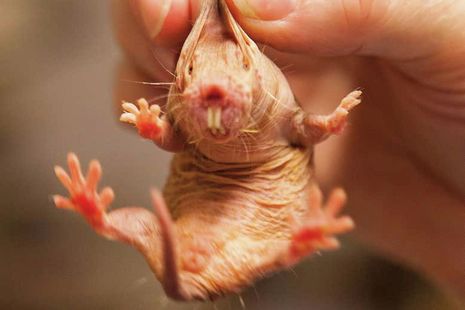Taking advantage of absurdity – the naked mole rat
Anna Papameletiou explains why this rodent is so unique, and what humanity can gain by studying its behaviour.

Insensitivity to pain and the ability to survive without oxygen sound like the qualities of a superhero. They are, in fact, just a few of the surprising physiological traits of a small, bizarre-looking East African burrowing rodent: the naked mole rat (Heterocephalus glaber). These fascinating abilities have made the naked mole rat the subject of various scientific studies and have contributed to it being named “Vertebrate of the Year” in 2013, as well as the foundation of the Naked Mole Rat Initiative by the University of Cambridge in 2014.
Naked mole rats live in large, underground colonies, in a eusocial system, much like the ones observed in insects such as bees. In fact, it is the only mammal to display this social system, where up to 300 animals are dominated by a single female, the queen. The queen is the only breeding female in each colony. Despite this unusual social behaviour, the naked mole rat has mostly been studied for its unique physiological qualities.
Although naked mole rats respond to some sensory stimuli such as touch and movement, they are insensitive to many others. For example, they do not perceive acid as noxious when applied subcutaneously. The voltage-gated sodium channel NaV1.7, highly conserved between species, is the physiological feature responsible. The channel is not usually inhibited by acid as it is in the naked mole rat, causing acid to act as an anaesthetic rather than eliciting pain. This is thought to be an evolutionary adaptation. The naked mole rat’s body tissues can often have a buildup of acid, due to them living in enclosed areas with high concentrations of carbon dioxide (CO2 reacts with water to form carbonic acid, which lowers the blood’s pH). Research into pain perception in naked mole rats has led to potential painkillers targeting the NaV 1.7 sodium channel being developed, which have made it into clinical trials.
“Perhaps the most superhero-like quality of the naked mole rat is its inability to spontaneously develop cancer.”
Another fascinating feature of the naked mole rat is its ability to resist hypoxia: its brain can withstand hours with extremely low levels of oxygen and can be completely deprived of oxygen for up to 18 minutes. This is likely another adaptation to living in burrows, a low oxygen and high CO2 environment, and is thought to be due to several metabolic and physiological peculiarities. The naked mole rat’s haemoglobin, the molecule responsible for carrying oxygen within the blood, has a very high affinity for oxygen. This means that oxygen uptake is much more efficient. Moreover, the naked mole rat’s cells can slow their metabolic rate as well as utilise fructose (rather than glucose which is used normally) to produce ATP (the molecule that cells use for energy) in low-oxygen conditions, in a process known as anaerobic glycolysis. This effect is quite similar to Warburg metabolism, which takes place in cancer cells, where cells respire anaerobically despite the presence of oxygen. Studying the naked mole rat’s hypoxia resistance has enabled scientists to understand how nerve cells are damaged when deprived of oxygen. The way that naked mole rats rewire their metabolism in low-oxygen conditions has been the foundation of research into molecular targets for treatments that prevent brain damage from hypoxia in stroke and ischemic heart disease patients.
Perhaps the most superhero-like quality of the naked mole rat is its inability to spontaneously develop cancer. This was thought to be due to the combination of two overcrowding genes, p16 and p27. These genes prevent cells from dividing when they are in close contact with other cells, making it much more difficult for cells to proliferate and form a tumour. Moreover, naked mole rats’ ribosomes, the organelles that translate RNA into proteins, have been found to be much more precise than in other mammals. Recent studies have also suggested that this resistance to cancer could also be due to extracellular factors, namely the animal’s immune system. Identifying the factors that prevent the formation of cancer in naked mole rats could be the first step towards researching potential treatments of the disease in humans.
Tying into the naked mole rat’s resistance to cancer is its impressive longevity: naked mole rats live up to 30 years, which is 10-15 times longer than mice of a similar size. Their health does not seem to decline with old age, and as such their mortality rate does not conform to the Gompertz-Makeham law of mortality (a mathematical formula describing death rate with respect to age), unlike most mammals. This longevity is thought to be due to the naked mole rat’s ability to reduce its metabolism by as much as 25%, evolved once again from living in low-oxygen environments. Moreover, naked mole rats have very little DNA damage, due to up-regulated DNA repair pathways and the over-expression of genes such as Terminal that protect telomeres from damage. Lastly, naked mole rats do not accumulate clusters of misfolded amyloid beta proteins, called amyloid plaques, in their brains. This prevents them from developing age-related neurodegenerative diseases, and have made them extremely interesting to scientists looking to prevent such diseases, namely Alzheimer’s and Parkinson’s, in humans.
Although the naked mole rat has many enviable characteristics, there are several areas in which other mammals have evolved significantly better attributes. Naked mole rats have poor eyesight and hearing, and are unable to regulate their own body temperature. Despite their evolutionary shortcomings, the complex nature of this peculiar mammal highlights the importance of studying the basic biology of other animals to help us further understand our own, as well as to potentially develop new therapeutic techniques.
 News / SU reluctantly registers controversial women’s soc18 December 2025
News / SU reluctantly registers controversial women’s soc18 December 2025 Features / Should I stay or should I go? Cambridge students and alumni reflect on how their memories stay with them15 December 2025
Features / Should I stay or should I go? Cambridge students and alumni reflect on how their memories stay with them15 December 2025 News / Dons warn PM about Vet School closure16 December 2025
News / Dons warn PM about Vet School closure16 December 2025 News / Cambridge study finds students learn better with notes than AI13 December 2025
News / Cambridge study finds students learn better with notes than AI13 December 2025 News / Uni registers controversial new women’s society28 November 2025
News / Uni registers controversial new women’s society28 November 2025










